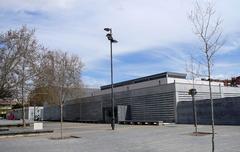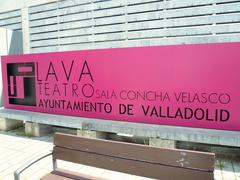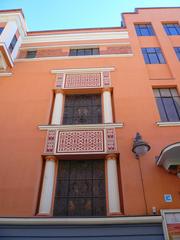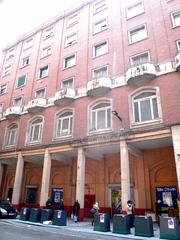
Valladolid University Visiting Hours, Tickets, and Historical Sites Guide
Date: 04/07/2025
Introduction
The University of Valladolid (Universidad de Valladolid, UVa) stands as one of Spain’s oldest and most esteemed universities. Founded in 1241, it has played a pivotal role in the intellectual, cultural, and architectural history of both Spain and Europe. Nestled in the heart of Valladolid’s historic center, the university is not only a center for academic excellence but also a showcase of medieval, Renaissance, and Baroque architecture. This guide provides a detailed overview of the university’s history, architectural highlights, notable alumni, and essential information for visitors—including opening hours, tickets, accessibility, guided tours, and nearby attractions.
Contents
- Medieval Origins and Foundation
- Academic Growth and Early Modern Development
- The University’s Role in Spanish and European Education
- Architectural Heritage
- Modernization and Expansion (19th–20th Centuries)
- Notable Figures and Alumni
- Practical Visitor Information
- Visiting Hours and Tickets
- Guided Tours
- Accessibility
- Travel Tips and Nearby Attractions
- Photography and Visual Highlights
- Frequently Asked Questions (FAQ)
- Conclusion
Medieval Origins and Foundation
The University of Valladolid traces its roots to the 13th century, with the most widely accepted foundation date being 1241. It emerged following the transfer of the General Study of Palencia, an institution established by Alfonso VIII of Castile, to the city of Valladolid—a move reflecting Valladolid’s growing political and economic clout in medieval Castile. The university began in the Abbey of Santa María la Mayor and operated under royal and papal patronage, solidifying its status as a center of learning and ecclesiastical authority (academia-lab.com; wikiwand.com).
Academic Growth and Early Modern Development
By the late 15th century, the university had established itself as a prominent scholarly center in Castile. The construction of its first significant building, featuring a four-sided cloister and late-Gothic chapel, set the architectural tone for expansion in later centuries. The curriculum grew to encompass theology, law, medicine, and the arts, mirroring the traditional faculties of European universities. The Renaissance and Baroque periods saw further expansion, including the addition of a new quadrangular cloister and classrooms in the early 18th century. The crowning architectural achievement was the Baroque façade, designed by Fray Pedro de la Visitación and completed in 1715, adorned with sculptures symbolizing various academic disciplines (spainthisway.com).
The University’s Role in Spanish and European Education
Throughout its history, the University of Valladolid has been instrumental in shaping Spanish intellectual and administrative life. It trained clergy, jurists, and civil servants for the monarchy and the Catholic Church, while also drawing students and scholars from across Spain and Europe. By the 16th and 17th centuries, Valladolid was recognized as a vibrant university town, rivaling Salamanca and Alcalá de Henares in prestige and influence (nomads-travel-guide.com).
Architectural Heritage
The university’s architectural ensemble is a testament to its rich and layered history. Notable highlights include:
- Baroque Façade: The main building’s façade, a masterpiece of Spanish Baroque, features Corinthian columns, allegorical sculptures, and intricate reliefs that symbolize the arts and sciences (archademia.com).
- Late-Gothic Cloisters: Serene courtyards that reflect the university’s medieval origins.
- Colegio de Santa Cruz: An early Renaissance patio, now housing the university library and often hosting art exhibitions.
- Nearby Landmarks: The university’s central location means it is surrounded by significant sites such as the unfinished Cathedral of Valladolid and the Church of San Pablo, offering a seamless integration of university and city heritage (turispanish.com; iuu.uva.es).
Modernization and Expansion (19th–20th Centuries)
The 19th and 20th centuries marked a period of significant transformation. The university broadened its academic scope to include sciences, engineering, and social sciences, and expanded geographically with campuses in Palencia, Soria, and Segovia (uniscopio.com; spanish-university.es). The 20th century was marked by episodes of political turmoil, including disruptions during the Spanish Civil War and the Franco era, but the university community demonstrated resilience, maintaining academic life even during times of official closure (academia-lab.com).
Notable Figures and Alumni
Among the university’s distinguished alumni is Manuel Belgrano, a key figure in Argentine history and the designer of the Argentine flag (edurank.org). The university has also awarded honorary doctorates to over sixty prominent Spanish and international figures (academia-lab.com). Valladolid itself was home to Christopher Columbus and Miguel de Cervantes, both of whom left a lasting imprint on the city’s cultural life (staffmobility.eu).
Practical Visitor Information
Visiting Hours and Tickets
- Main Campus and Baroque Façade: Open to visitors Monday to Friday, 9:00 AM–7:00 PM. Public holidays may affect opening hours.
- Guided Tours: Available Tuesday to Saturday at 11:00 AM and 4:00 PM. Advance booking is recommended.
- Tickets: General access to exterior and public spaces is free. Guided tours typically cost €5 per person, with discounts for students, seniors, and groups. Special exhibitions may have separate fees.
For the latest updates, refer to the University of Valladolid Official Website.
Guided Tours
Guided tours offer deeper insights into the university’s history, art, and architecture. Tours often include access to restricted areas such as the Colegio de Santa Cruz and main cloisters.
Accessibility
Many university buildings offer ramps, elevators, and accessible restrooms. Some historic spaces may have limited access, so visitors with specific needs are encouraged to contact the university’s visitor services before arrival.
Photography and Visual Highlights
Photography is permitted in most public areas, especially the Baroque façade and Gothic cloisters. However, some interior spaces may have restrictions—please check at the reception desk.
Travel Tips and Nearby Attractions
- Getting There: The university is centrally located, easily accessible by bus, bike, or on foot. The Valladolid-Campo Grande train station is nearby.
- Nearby Attractions: Plaza Mayor, Valladolid Cathedral, National Museum of Sculpture, and Casa de Cervantes are all within walking distance.
- Amenities: Cafés and restaurants surrounding the campus offer local cuisine and refreshments.
Cultural Events and Special Programs
The University of Valladolid serves as a cultural hub, hosting concerts, exhibitions, and theater performances throughout the year. Notable events include performances by the university’s youth symphonic orchestra (JOUVa), choir, and theater groups. The university also participates in citywide festivals such as Semana Santa and the Valladolid International Film Festival (1xmarketing.com).
Frequently Asked Questions (FAQ)
Q: What are the main visiting hours?
A: Monday to Friday, 9:00 AM–7:00 PM. Guided tours are available Tuesday through Saturday by advance booking.
Q: Are tickets required for entry?
A: Public areas are free; guided tours and special exhibitions require a ticket.
Q: Is the university accessible to visitors with disabilities?
A: Yes, most public spaces are adapted for accessibility, though some historic areas have limitations.
Q: Are guided tours available in English?
A: Yes, English-language tours can be arranged upon request.
Q: Can I take photographs inside the university?
A: Yes, in most public spaces, but check for any area-specific restrictions.
Q: What other attractions are nearby?
A: Plaza Mayor, Valladolid Cathedral, National Museum of Sculpture, and Casa de Cervantes are within easy reach.
Conclusion
A visit to the University of Valladolid is an invitation to explore eight centuries of learning, art, and civic pride. Its architectural gems, academic tradition, and dynamic cultural scene make it a must-see destination in Valladolid. Whether you are a history buff, architecture enthusiast, or cultural traveler, the university’s blend of past and present offers a memorable experience.
To make the most of your visit, plan ahead for tours, check for special events, and explore the surrounding cityscape. Download the Audiala app for guided tours and up-to-date event information, and follow us for more insights into Valladolid’s heritage.
Internal Links
External Links
Summary and Visitor Recommendations
The University of Valladolid offers visitors a unique opportunity to immerse themselves in centuries of academic excellence and cultural vibrancy. Its historical buildings, from the Baroque main façade to Gothic cloisters and Renaissance patios, create a compelling narrative of Spain’s educational and architectural evolution. With accessible visiting hours, affordable guided tours, and proximity to other major city attractions, the university is an essential stop for anyone seeking a comprehensive cultural experience in Valladolid (academia-lab.com; spainthisway.com; turispanish.com).
References and Further Reading
- academia-lab.com – University of Valladolid
- turispanish.com – Valladolid Travel Guide
- iuu.uva.es – Institute Background
- spainthisway.com – Valladolid Places
- nomads-travel-guide.com – Valladolid City Guide
Enhance your visit by downloading the Audiala app for guided tours, event notifications, and insider tips on Valladolid’s cultural landmarks. Follow us on social media for the latest updates and discover more about Spain’s historic treasures.





